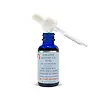What's inside
What's inside
 Key Ingredients
Key Ingredients

 Benefits
Benefits

 Concerns
Concerns

 Ingredients Side-by-side
Ingredients Side-by-side

Water
Skin ConditioningGlycerin
HumectantPropylene Glycol
HumectantPolysorbate 80
EmulsifyingPhenoxyethanol
PreservativeSodium Benzoate
MaskingSodium Hyaluronate
HumectantHydroxyethylcellulose
Emulsion StabilisingDisodium EDTA
Olea Europaea Leaf Extract
PerfumingParfum
MaskingBenzophenone-4
UV AbsorberButylene Glycol
HumectantCitrus Grandis Extract
AntimicrobialCucumis Sativus Fruit Extract
EmollientBenzyl Benzoate
AntimicrobialCI 19140
Cosmetic ColorantThymus Vulgaris Flower/Leaf Extract
MaskingEucalyptus Globulus Leaf Oil
PerfumingBenzyl Alcohol
PerfumingAlpha-Isomethyl Ionone
PerfumingCI 42090
Cosmetic ColorantLinalool
PerfumingCitronellol
PerfumingMorus Alba Root Extract
BleachingWater, Glycerin, Propylene Glycol, Polysorbate 80, Phenoxyethanol, Sodium Benzoate, Sodium Hyaluronate, Hydroxyethylcellulose, Disodium EDTA, Olea Europaea Leaf Extract, Parfum, Benzophenone-4, Butylene Glycol, Citrus Grandis Extract, Cucumis Sativus Fruit Extract, Benzyl Benzoate, CI 19140, Thymus Vulgaris Flower/Leaf Extract, Eucalyptus Globulus Leaf Oil, Benzyl Alcohol, Alpha-Isomethyl Ionone, CI 42090, Linalool, Citronellol, Morus Alba Root Extract
Simmondsia Chinensis Seed Oil
EmollientIsodecyl Neopentanoate
EmollientColloidal Oatmeal
AbsorbentCannabis Sativa Seed Oil
EmollientBorago Officinalis Seed Oil
EmollientRosmarinus Officinalis Leaf Oil
MaskingPersea Gratissima Oil
Skin ConditioningButyrospermum Parkii Oil
EmollientOryza Sativa Bran Extract
Skin ConditioningCamellia Sinensis Leaf Extract
AntimicrobialRibes Nigrum Seed Extract
EmollientChlorella Vulgaris Extract
Skin ConditioningPanax Ginseng Root Extract
EmollientChrysanthemum Parthenium Extract
Skin ConditioningGlycyrrhiza Glabra Root Extract
BleachingArnica Montana Flower Extract
MaskingGlycerin
HumectantVitis Vinifera Seed Oil
EmollientTocopheryl Acetate
AntioxidantRicinoleth-40
CleansingButylene Glycol
HumectantWater
Skin ConditioningLeuconostoc/Radish Root Ferment Filtrate
AntimicrobialPhenoxyethanol
PreservativeEDTA
Citric Acid
BufferingLimonene
PerfumingLinalool
PerfumingSimmondsia Chinensis Seed Oil, Isodecyl Neopentanoate, Colloidal Oatmeal, Cannabis Sativa Seed Oil, Borago Officinalis Seed Oil, Rosmarinus Officinalis Leaf Oil, Persea Gratissima Oil, Butyrospermum Parkii Oil, Oryza Sativa Bran Extract, Camellia Sinensis Leaf Extract, Ribes Nigrum Seed Extract, Chlorella Vulgaris Extract, Panax Ginseng Root Extract, Chrysanthemum Parthenium Extract, Glycyrrhiza Glabra Root Extract, Arnica Montana Flower Extract, Glycerin, Vitis Vinifera Seed Oil, Tocopheryl Acetate, Ricinoleth-40, Butylene Glycol, Water, Leuconostoc/Radish Root Ferment Filtrate, Phenoxyethanol, EDTA, Citric Acid, Limonene, Linalool
 Reviews
Reviews

Ingredients Explained
These ingredients are found in both products.
Ingredients higher up in an ingredient list are typically present in a larger amount.
Butylene Glycol (or BG) is used within cosmetic products for a few different reasons:
Overall, Butylene Glycol is a safe and well-rounded ingredient that works well with other ingredients.
Though this ingredient works well with most skin types, some people with sensitive skin may experience a reaction such as allergic rashes, closed comedones, or itchiness.
Learn more about Butylene GlycolGlycerin is already naturally found in your skin. It helps moisturize and protect your skin.
A study from 2016 found glycerin to be more effective as a humectant than AHAs and hyaluronic acid.
As a humectant, it helps the skin stay hydrated by pulling moisture to your skin. The low molecular weight of glycerin allows it to pull moisture into the deeper layers of your skin.
Hydrated skin improves your skin barrier; Your skin barrier helps protect against irritants and bacteria.
Glycerin has also been found to have antimicrobial and antiviral properties. Due to these properties, glycerin is often used in wound and burn treatments.
In cosmetics, glycerin is usually derived from plants such as soybean or palm. However, it can also be sourced from animals, such as tallow or animal fat.
This ingredient is organic, colorless, odorless, and non-toxic.
Glycerin is the name for this ingredient in American English. British English uses Glycerol/Glycerine.
Learn more about GlycerinLinalool is a fragrance and helps add scent to products. It's derived from common plants such as cinnamon, mint, citrus, and lavender.
Like Limonene, this ingredient oxidizes when exposed to air. Oxidized linalool can cause allergies and skin sensitivity.
This ingredient has a scent that is floral, spicy tropical, and citrus-like.
Learn more about LinaloolPhenoxyethanol is a preservative that has germicide, antimicrobial, and aromatic properties. Studies show that phenoxyethanol can prevent microbial growth. By itself, it has a scent that is similar to that of a rose.
It's often used in formulations along with Caprylyl Glycol to preserve the shelf life of products.
Water. It's the most common cosmetic ingredient of all. You'll usually see it at the top of ingredient lists, meaning that it makes up the largest part of the product.
So why is it so popular? Water most often acts as a solvent - this means that it helps dissolve other ingredients into the formulation.
You'll also recognize water as that liquid we all need to stay alive. If you see this, drink a glass of water. Stay hydrated!
Learn more about Water